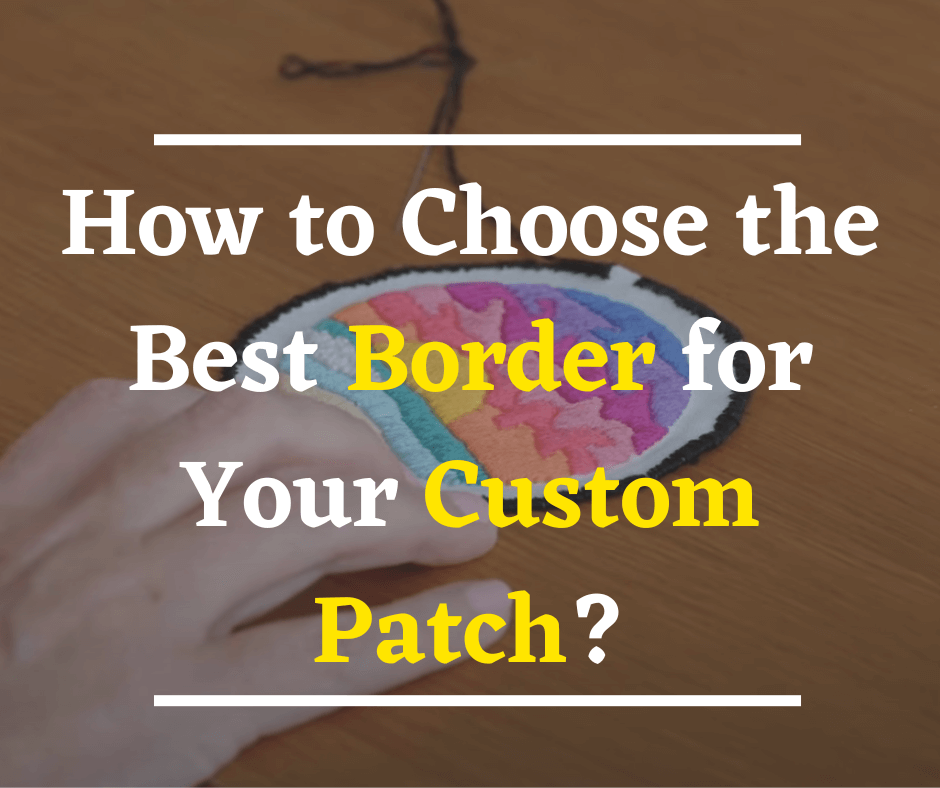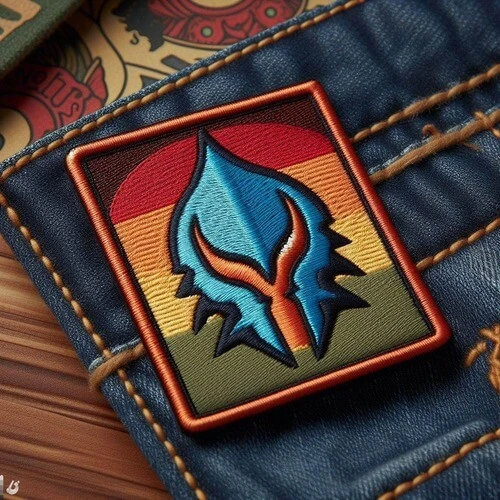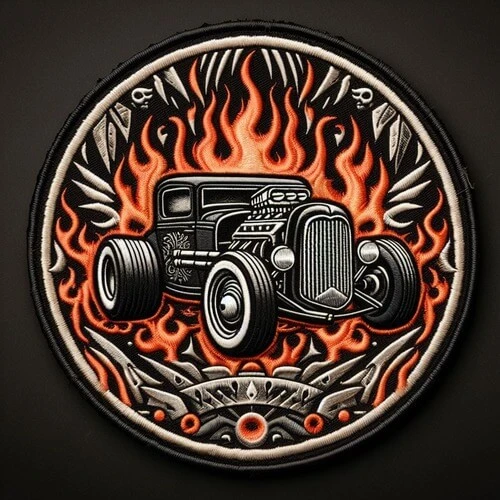
Custom patches have become a popular choice for personalizing garments, bags, accessories, backpacks, hats, and even embroidered artwork. They offer a unique way to express your personal style, showcase your brand, or commemorate special events.
One crucial aspect of creating the perfect custom patch is choosing the right border. The border not only adds to the aesthetics but also affects the patch’s durability and overall appearance. Lets explore two main border options for custom patches: merrowed and hot cut borders.
Merrowed Border

A merrowed border is a classic choice for custom patches. It is created using a specialized sewing machine that wraps thread around the edge of the patch, giving it a timeless and elegant look. This border option has a few distinct advantages:
Classic Look
Merrowed borders are known for their classic and traditional appearance. They add a touch of sophistication to your custom patch, making it suitable for a wide range of personal preference and garment types.
Thickness and Sturdiness
Merrowed borders are relatively thick and sturdy. They provide extra durability to the patch, making it less susceptible to wear and tear, especially in high-stress areas.
Fray Prevention
One of the primary benefits of a merrowed border is its ability to prevent fraying or unraveling of the patch’s edges. This is particularly important for patches that will be exposed to rough handling or frequent washing.
While merrowed borders have many advantages, they also come with certain limitations:
- Shape Restrictions – Merrowed borders work best with simple shapes and designs. Intricate or complex shapes may not be suitable for this type of border due to the limitations of the sewing machine.
- Design Matching – Matching the thread color of the merrowed border to the patch design can be challenging. This may limit your color choices and affect the overall aesthetic appeal.
- Higher Cost – Merrowed borders tend to be more expensive than hot cut borders due to the specialized machinery and labor required for their creation.
Hot Cut Border

Hot cut borders offer a different approach to custom patch borders. They are created by cutting the patch as close as possible to the embroidery using a laser or hot scissors, and then melting the remaining material to form a seal. Hot cut borders have their own set of advantages:
Flexibility for Intricate Shapes
Hot cut borders are ideal for patches with intricate or complex shapes. They provide a clean and precise finish, allowing you to achieve detailed designs.
Smooth and Flat Appearance
The absence of a raised border gives hot cut patches a smooth and flat appearance. This can be particularly appealing when you want your patch to seamlessly blend with the garment or accessory.
Cost-Effectiveness
Hot cut borders are generally more cost-effective than merrowed borders, making them a budget-friendly choice for large quantities of custom patches.
However, hot cut borders also have their limitations:
Distinction Difficulty – The lack of a distinct border can make hot cut patches less noticeable on the garment, which may not be ideal for patches intended to stand out prominently.
Edge Curling – Over time, hot cut borders may be prone to curling or peeling, especially if they are exposed to rough handling or washing. This can affect the patch’s longevity.
Embroidery Coverage Requirement – Hot cut borders work best when the patch has 100% embroidery coverage. If your design includes empty spaces or non-embroidered areas, hot cut borders may not be the best choice.
Choosing the Right Border
When choosing the best border for your custom patch, consider the following factors:
Design Versatility – If your design is intricate or complex, a hot cut border may be the better choice. For simpler designs, a merrowed border can provide a classic touch.
Sleek Appearance – If you prefer a smooth and flat appearance, opt for a hot cut border. For a more traditional look, go with a merrowed border.
Cost Considerations – If you’re working within a budget, hot cut borders are usually more cost-effective, especially for larger quantities.
Distinction – If you want your patch to stand out distinctly on the garment or accessory, a merrowed border may be preferable.
Wrap Up!
Selecting the right border for your custom patch is crucial for achieving the desired look and durability.
Whether you opt for the timeless elegance of a merrowed border or the sleek finishing of a hot cut border, your choice should align with your design, budget, and personal preference.
If you need further assistance in making this decision or want to explore creative options, consider reaching out to a creative specialist or visiting a website specializing in custom patches. Your custom patch is a unique expression of your style or brand, and choosing the perfect border is a vital step in bringing your vision to life.
FAQs
What are the different types of borders for custom patches?
There are two main types of borders for custom patches: merrowed borders and heat-cut borders. Merrowed borders are created by wrapping thread around the edge of the patch, giving it a classic, raised appearance. Heat-cut borders, on the other hand, involve cutting the patch as close as possible to the embroidery and melting the remaining material to create a seal, resulting in a smooth and flat edge.
How do I choose the right border for my custom patch?
To choose the right border for your custom patch, consider factors such as your design complexity, preferred appearance (classic or sleek), budget, and the level of distinction you want on the garment or accessory. For intricate designs and a smooth appearance, opt for heat-cut borders. For classic looks and durability, merrowed borders are a great choice. Your decision should align with your specific needs and preferences.
What is the difference between a merrowed border and a heat-cut border?
The main difference between a merrowed border and a heat-cut border lies in their appearance and production method. Merrowed borders have a raised, classic look created by wrapping thread around the patch’s edge using a special sewing machine. Heat-cut borders, on the other hand, have a smooth and flat appearance achieved by cutting the patch close to the embroidery and sealing the edge using
heat. The choice between them depends on your desired aesthetics and other considerations.
What is the best type of border for embroidered patches?
Both merrowed and heat-cut borders can be suitable for embroidered patches, but the choice depends on your specific design and preferences. If your embroidered patch has intricate details and you prefer a smooth appearance, a heat-cut border may be ideal. However, if you want a classic, raised border and your design allows for it, a merrowed border can also work well.
What is the best type of border for woven patches?
Woven patches typically have a finer texture and intricate details. Heat-cut borders are often preferred for woven patches because they provide a clean, flat edge that complements the detailed weaving. The choice enhances the appearance of woven patches and prevents any fraying or unraveled edges.
What is a merrowed border?
A merrowed border is a type of border for custom patches created by a specialized sewing machine that wraps thread around the edge of the patch. The process gives the patch a classic, raised appearance and enhances its durability by preventing fraying or unraveling along the edges. Merrowed borders are known for their timeless elegance and sturdiness.
What is a heat-cut border?
A heat-cut border is a type of border for custom patches achieved by cutting the patch as close as possible to the embroidery and then melting the remaining material to create a seal. This results in a smooth, flat edge that blends seamlessly with the garment or accessory. Heat-cut borders are known for their sleek appearance and flexibility for intricate designs.
How do I decide which border option is right for me?
To decide which border option is right for you, consider your patch design, budget, and personal preference. If your design is simple and you prefer a classic look, merrowed borders may be suitable. For intricate designs, a smooth finish, and cost-effectiveness, heat-cut borders are a great choice. Evaluate your specific needs and aesthetics to make an informed decision on the border type that best suits your
custom patch.
